

Photo: The hybrid powertrain of the Porsche 919 Hybrid. The V4 petrol engine with direct injection and turbocharging is integrated in the chassis as a mid-engine. The batteries at the centre of the vehicle supply the electric motor at the front axle with energy.
With a podium finish at the start of the 2014 FIA World Endurance Championship in Silverstone and pole position in the WEC 6 Hours of Spa-Francorchamps, Porsche is proud of its return to the premier league of sports car racing.
It is also justifiably proud of its hybrid power system which is about to face its sternest test at the 24 Hours of Le Mans, the third round of the FIA WEC. Porsche’s new 919 Hybrid is the most complex racing car that the sports car manufacturer has ever built, and it will use hybrid power alongside its petrol-fuelled, 2-litre V4 turbo engine.

Photo: The single electric motor distributes its power to the two front wheels via a differential as needed. The highly advanced energy management unit for the battery is located near the centre of the vehicle.
The amount of electrical energy each driver can use per lap at Le Mans - delivered as a boost - is limited by the regulations and there are four classes of energy levels available ranging from 2 to 8 MegaJoules (MJ). Porsche has registered the 919 Hybrid for the 6 MJ category, which means that the LMP1-H prototype can use exactly 1.67 kilowatt hours (kWh) of energy per 13,629 km lap. But what does this mean in real terms?
In 2013, winner Audi Sport Team Joest covered 348 laps. Calculated over the same distance the new 919 Hybrid generates and uses 581.2 kilowatt hours (kWh) of energy – an electric output which would run a 60 watt light bulb for a staggering 9,687 hours.
To equate it to a regular production road car, the energy the Porsche 919 Hybrid recuperates during the 24 Hours of Le Mans would allow you to cover 4,576 km in the super-efficient new Volkswagen e-Golf. This would take you across the USA from coast to coast, from New York to Los Angeles!
Data from Porsche